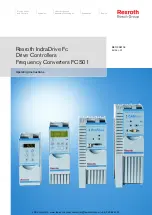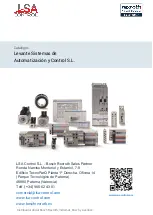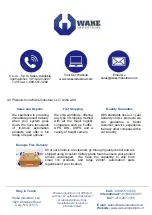
Page 19
IronHorse GSD8 DC Drives User Manual – 1st Ed. Rev. A – 10/15/2019
All other GSD8 drives
•
Rate Mode Operation in RPM
•
S1 and S2 Signal Input Pulses per Revolution: 1, 10, or 20 (depending on magnet in PU2x)
•
Decimal Point Display: None
•
Display Range: 0 - 2400
•
Speed Range: 0 - 2400 RPM
•
Accel and Decel: 9999 RPM per second
•
Signal Input 2 (S2) Mode: Jog @ 1000 RPM when Low
•
User Input 1 (UIN1) Mode: Emergency Stop when Low
•
Alarm 1 and Alarm 2 Outputs: Disabled
Resetting the GSD8 to Factory Defaults
The factory-default settings can be easily restored using either of two methods. Both methods require
the Program Enable jumper to be in the “On” position. The first is to apply power to the unit with both
the Enter and Down buttons pressed for 3 seconds. The second is to change the value of Parameter 95
to 5.
Setting and Reading “SoftSwitches”
The GSD8 drive has the ability to select between a number of “yes/no” or “on/off” options, depending
upon the application. Traditionally, this sort of option-selecting was done with some sort of physical
switch or switches (such as a “DIP switch”), or by other means, such as the “jumper block” used to
enable/disable Programming on the GSD8.
It is easiest to think of a parameter containing SoftSwitches as a DIP switch containing from one to
thirty-two switches. But instead of actually flipping a switch “on” or “off”, you can set and read these
“switches” as a decimal number. Each “switch”, from #1 through #32, has been assigned a decimal
number that represents its position in the assembly. When that number is used, it means that the
switch is “on”. For example, the decimal number that represents switch #4 is 8, the number that
represents switch #6 is 32, and so on. See the table below for a full explanation of these values. Note:
Due to display limitations, switches 15 through 32 are currently unused.
Switch Number
Decimal Value
1
1
2
2
3
4
4
8
5
16
6
32
7
64
8
128
9
256
10
512
11
1024
12
2048
13
4096
So, the decimal number contained in a SoftSwitch Parameter is the sum of the numbers representing
the “on” switches. For example, if you wanted to set switches #1, #4, and #7 to the “on” position,
you would place the number 73 (1 + 8 + 64) into the Parameter containing those SoftSwitches; if you
wanted to set switches #5 and #6 “on”, you would place the number 48 (16 + 32) into the Parameter.
Simply “add-up” the decimal values of the switches you wish to “turn on”, and place the total, or
“sum”, into the Parameter containing the SoftSwitches.
The settings of the SoftSwitches can also be read the same way: For example, if a parameter
containing the SoftSwitches has been set to the number 11, you can tell that switches #1, #2 and #4
are “on” by subtracting the values, from highest to lowest, starting at the highest value that is less
than or equal to the “total”. Continue subtracting, avoiding negative numbers until you reach zero.
















































